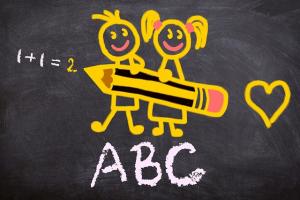
As I mentioned earlier this week, Rose and I have finished our first year of homeschooling– Kindergarten, plus about eight weeks of first grade, and we’ve started second grade in math. I already told the story of how I second guessed myself and how it turned out to be the right choice, just for us. I have no idea what works for other people, other than the Decalogue and the Golden Rule. But homeschooling worked for us and this technique, which I made up based on bits of other methods and just figuring out what was practical, has worked very well so far.
I do not care if or where you send your child to school. School is a means to an end. If you’ve found something that works for you, that’s all you need. Some families are just naturally homeschooling families and couldn’t do it any other way. Some are Catholic school families. Some public school and Catechism on Sundays families. Some are Montessori families. Some are families who do one thing one year and one thing another because their needs change. All of these are great families and I like all of them. But it turns out that the Pezzulos are a homeschooling family. I wanted to write down what’s worked for us so far, because I know a lot of people choose not to homeschool because of the cost and I’ve stumbled on a method that costs very little. I had to come up with this, since money’s so tight around here. We could never have afforded to just order a big curriculum from anywhere, so I did something else that seems to work better anyway.
The state of Ohio requires that you teach your children language arts; math; science; geography; international, national and state history; health and safety, physical education and fine arts. It also requires that your children do 900 hours of school during the school year. The “900 hours” thing scared me until I remembered: when public schools send the children to lunch, they count it toward their hours. When they drive the kids on field trips, time spent in the car and in line at the zoo or museum counts as hours. Playing with toys in the Kindergarten classroom counts as hours. Gym class counts as hours. Rolling in the TV cart and making all the kids watch a Disney movie for a treat even if the kids don’t like Disney movies counts as hours. A guest artist showing up and singing annoying folk songs to the children is hours. Recess is hours. Picture Day is hours. Every minute spent in the school building and with a teacher or chaperone, counts as hours. And when you homeschool, you are the teacher and the whole world is your school building. Get what I’m saying? Everything that causes learning to happen counts toward your hours. You’ll do fine.
I broke down Rose’s curriculum into three basic categories. The first category was the traditional “three R’s” of reading, writing and arithmetic. A child who hasn’t learned the three R’s can’t really learn any other school subject, so they’re the most important and typically most time-consuming. There were plenty of days when I was too worn out or busy to do a lot of formal school work, so on those days we only did the three R’s and Rose spent the rest of the day on other educational pursuits like coloring, building marble runs and playing in the sand. When she went on hikes with her father to give me a quiet house for the afternoon I counted it as physical education. Remember, everything that teaches counts as hours.
All my reading and language arts materials I got from scribd.com, which costs $8.99 a month after the free sample month. Scribd is an enormous library of ebooks, audio books and pdfs you have access to in unlimited quantities for that one monthly fee. They currently have the Explode the Code phonics series available, which I downloaded; we mostly read this on the computer screen, but you could print the whole thing off and make your own textbook for the cost of ink and staples. We also listened to audio books constantly on Scribd– Rose loved the Ramona and Henry Huggins books, and she’s now working her way through all of The Boxcar Children and the Wayside School series. Listening to audiobooks saved my throat and meant I could get work done while Rose was listening– and that Rose could play or do her chores while listening to stories rather than having to sit still. When she was able to sound out words, we added readers such as the Bob Books which we got from Scribd, checked out of the library or borrowed for free from my library network’s hoopla digital account.
I bought some fancy handwriting books online but frankly I found that to be a waste of money– with Rose’s motor skills and attention span, it was much better for her to trace and draw letters in the handwriting tablets you can get at Dollar General or Ollie’s for just over a dollar each. Remember, school is a means to an end. It doesn’t matter how children learn to write, only that they write legibly. Rose is getting there.
I bought a math book online for Kindergarten but that also turned out to be a mistake, because Rose learned math much better from the math games on starfall.com. Starfall has several free games in math, phonics and other subjects, but it’s worth it to pay to play the whole thing for about $25 a year. It would be worth ten times that much. Rose played the math games for about twenty minutes a day and shot right through all her milestones for Kindergarten and first grade with hardly any input from me. When we stated second grade math I added the Singapore Math Level One book just to make sure she was learning everything she was supposed to. I bought Singapore Math on Amazon for less than twenty dollars and I’ve not yet needed a teacher’s guide.













